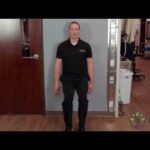Lower Trunk Rotation Stretch | Early Intervention Ergonomics
What is the Lower Trunk Rotation with Supine IR Quadratus Stretch?
The Lower Trunk Rotation with Supine Internal Rotation (IR) Quadratus Stretch is an effective stretching exercise that specifically targets the muscles in the lower trunk and hips. This exercise is frequently employed in rehabilitation and sports training settings to improve mobility and flexibility in the hip and lower back regions. To perform this stretch, follow this step-by-step guide:
- Begin by lying on your back in a supine position on a flat surface like a mat or a bed.
- Extend both legs fully along the floor.
- Bend your right knee and place your right foot flat on the floor, while keeping your left leg extended.
- Extend your arms straight out to the sides, parallel to the floor.
- Slowly and gently lower your right knee across your body towards the left side, while ensuring your shoulders and left foot stay in contact with the surface.
- Maintain a relaxed and comfortable position, avoiding excessive twisting or strain in your lower back.
- Hold the stretch for 15 to 30 seconds, experiencing a gentle stretch in the muscles of your lower back and hip.
- Return your right knee to the starting position and repeat the stretch on the opposite side.
A Beneficial Addition to this Stretch
For an added benefit, you can incorporate supine internal rotation of the quadratus lumborum (QL) muscle:
- After lowering your right knee towards the left side, keep your right foot in contact with the surface and internally rotate your right hip.
- This movement will cause a slight rotation of your lower trunk, effectively targeting the quadratus lumborum muscle on the right side.
- Hold the stretch with the internal rotation for 15 to 30 seconds.
- Return your right knee to the starting position and repeat the stretch on the opposite side, incorporating internal rotation as well.
It’s crucial to note that if you have any pre-existing injuries or medical conditions, or if you feel pain or discomfort while performing this stretch, it is advisable to consult a qualified healthcare professional or physical therapist before attempting it. They can provide personalized guidance based on your specific needs, ensuring that you execute the exercise correctly and safely.
Early Intervention Benefits
The Lower Trunk Rotation with Supine Internal Rotation (IR) Quadratus Stretch offers several early intervention benefits. Here are some of the key advantages:
- Improved lower back and hip flexibility: By regularly performing this stretch, you can effectively target the muscles in the lower trunk and hips, including the quadratus lumborum. This muscle plays a crucial role in the lateral flexion and rotation of the spine. As a result, you can experience an increase in flexibility and range of motion in these areas. This, in turn, reduces the risk of stiffness and facilitates improved movement patterns.
- Enhanced spinal mobility: The rotational aspect of this stretch helps improve spinal mobility, particularly in the lower back region. It allows for greater rotation and movement between the vertebrae, which can contribute to a healthier and more functional spine.
- Injury prevention: By increasing flexibility, range of motion, and spinal mobility, the Lower Trunk Rotation with Supine IR Quadratus Stretch can help prevent injuries, especially in the lower back, hips, and surrounding muscles. The tightness and limited mobility in these areas can have adverse effects, such as compensatory movements and excessive stress on other structures. As a result, this increases the vulnerability to strains, sprains, and various musculoskeletal issues. However, by regularly incorporating this stretch into your routine, you can effectively counteract these risks. This stretch helps in maintaining optimal mobility and thereby significantly reduces the likelihood of experiencing such injuries.
- Core muscle activation and stability: During this stretch, your core muscles, including the abdominals and obliques, work to stabilize the pelvis and spine. By engaging these muscles, you can improve core strength and stability, which are crucial for maintaining proper posture and preventing excessive strain on the lower back.
Things to Remember
It is vital to perform this stretch with proper technique and actively avoid any movements or positions that induce pain or discomfort. Moreover, if you have any underlying medical conditions or concerns, it is highly recommended to consult with a healthcare professional or a qualified physical therapist. Their expertise can provide personalized guidance, ensuring the exercise is suitable for your specific needs and circumstances.
These early intervention exercises are to improve overall health & fitness as well as help reduce work-related injuries.
If you have an injury or illness, consult with a health care professional before attempting.
More Tools & Resources from Peak Ergonomics
Contact Us About Reducing Workplace Injuries
Healthy Employees are the Bottom Line! – Learn More!


